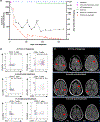Expanding the molecular and phenotypic spectrum of CTLA-4 insufficiency
- PMID: 38351878
- PMCID: PMC12019878
- DOI: 10.1111/pai.14077
Expanding the molecular and phenotypic spectrum of CTLA-4 insufficiency
Conflict of interest statement
CONFLICT OF INTEREST STATEMENT
The authors have no conflicts of interest to disclose.
Figures


Similar articles
-
The new quest in CTLA-4 insufficiency: How to immune modulate effectively?J Allergy Clin Immunol. 2022 Feb;149(2):543-546. doi: 10.1016/j.jaci.2021.11.020. Epub 2021 Dec 13. J Allergy Clin Immunol. 2022. PMID: 34915039 No abstract available.
-
CHAI and LATAIE: new genetic diseases of CTLA-4 checkpoint insufficiency.Blood. 2016 Aug 25;128(8):1037-42. doi: 10.1182/blood-2016-04-712612. Epub 2016 Jul 14. Blood. 2016. PMID: 27418640 Free PMC article. Review.
-
What did we learn from CTLA-4 insufficiency on the human immune system?Immunol Rev. 2019 Jan;287(1):33-49. doi: 10.1111/imr.12721. Immunol Rev. 2019. PMID: 30565239 Review.
-
Comparing the levels of CTLA-4-dependent biological defects in patients with LRBA deficiency and CTLA-4 insufficiency.Allergy. 2022 Oct;77(10):3108-3123. doi: 10.1111/all.15331. Epub 2022 May 12. Allergy. 2022. PMID: 35491430
-
Treg-expressed CTLA-4 depletes CD80/CD86 by trogocytosis, releasing free PD-L1 on antigen-presenting cells.Proc Natl Acad Sci U S A. 2021 Jul 27;118(30):e2023739118. doi: 10.1073/pnas.2023739118. Proc Natl Acad Sci U S A. 2021. PMID: 34301886 Free PMC article.
Cited by
-
Case Report: Aplastic anemia related to a novel CTLA4 variant.Front Pediatr. 2024 Aug 16;12:1434076. doi: 10.3389/fped.2024.1434076. eCollection 2024. Front Pediatr. 2024. PMID: 39220156 Free PMC article.
References
-
- Egg D, Rump IC, Mitsuiki N, et al. Therapeutic options for CTLA-4 insufficiency. J Allergy Clin Immunol. 2022;149(2):736–746. - PubMed
-
- Sun D, Heimall J. Disorders of CTLA-4 expression, how they lead to CVID and dysregulated immune responses. Curr Opin Allergy Clin Immunol. 2019;19(6):578–585. - PubMed
Publication types
MeSH terms
Substances
Grants and funding
LinkOut - more resources
Full Text Sources

